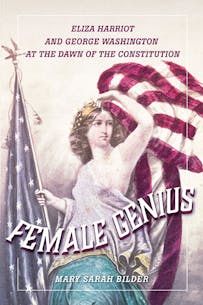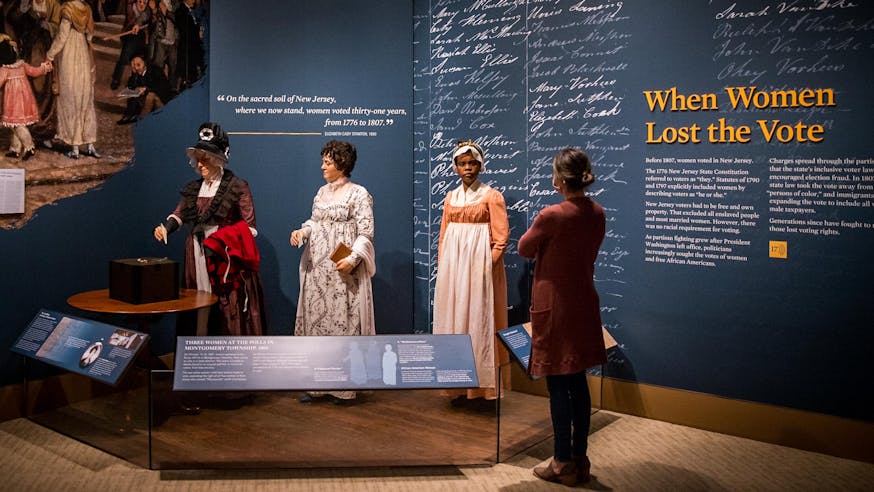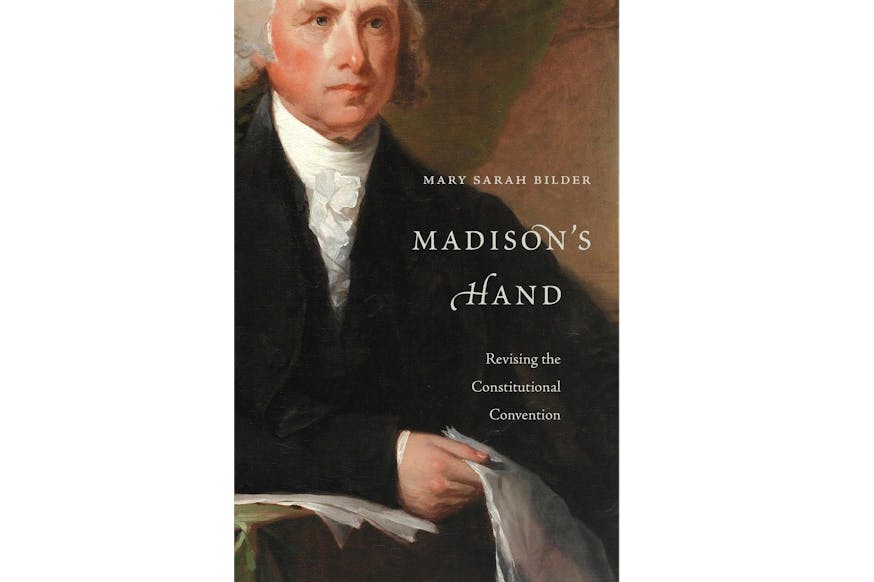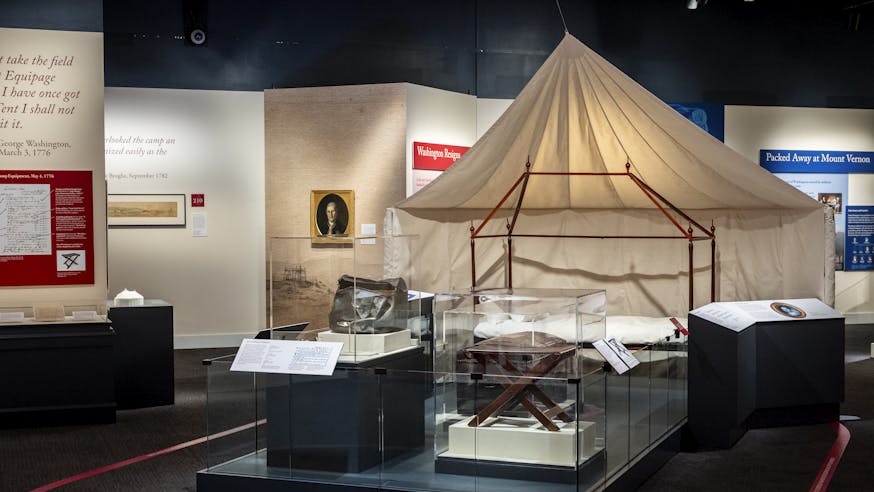Read the Revolution
Female Genius
March 27, 2024
Purchase the book from University of Virginia Press.
In the hot summer of 1787, while men from across the United States gathered to rethink their system of government, another innovator was hard at work in the halls of Philadelphia. Eliza Harriot (1749-1811) pioneered a public role for American women as a public speaker, teacher, and intellectual, becoming the emblem of a new idea: female genius.
In her new biography, Female Genius: Eliza Harriot and George Washington at the Dawn of the Constitution, historian Mary Sarah Bilder reconstructs the transatlantic journeys and travails of Harriot. She traces how Harriot’s public activities fit within a revolutionary age that produced the new federal Constitution as well as a reactionary backlash against some of the American Revolution’s more radical propositions.
In this excerpt, follow Harriot as she capitalizes on a successful lecture series, including the one attended by George Washington, and proposes a new Philadelphia school run by women, for women.
Excerpt
By the beginning of June 1787, almost all the men who would become famous as important players at the federal convention had arrived: Alexander Hamilton, James Madison, George Mason, Edmund Randolph, John Dickinson, Charles Pinckney, John Rutledge, Benjamin Franklin, Gouverneur Morris, and James Wilson. The convention was well underway. And the scope of Eliza Harriot’s ambition surfaced: an Academy of Belles Lettres—but one for women, led by a woman, and governed by an equal number of women and men.
On Wednesday, May 30, comments on the lady lecturer appeared immediately following the Pennsylvania Herald’s publication of news about the federal convention and the names of the delegates. These same comments ran in the Independent Gazetteer on Saturday, June 2. The text followed so closely the long list of delegate names that readers might have assumed the commentary still discussed the convention. The remarks on Eliza Harriot were followed by the report that George Washington, along with “respectable members of the protestant and dissenting churches,” had attended a Catholic service. By prominently sandwiching the female lecturer between two accounts relating to George Washington, her activities seemed to represent the liberal public spirit.
Eliza Harriot’s lectures intended to inspire younger women who would surpass her accomplishments. The anonymous correspondent—likely Eliza Harriot herself, given that similar words soon graced the prospectus for her academy— expressed regret that the lectures were “soon to be discontinued.” In discharging the “arduous” undertaking with “peculiar merit,” Eliza Harriot as female lecturer had established an example for future aspiring people. The correspondent explained, “The exertions of a female . . . should be considered in the important light of presenting an example to be imitated and improved upon by future candidates for literary fame.” Eliza Harriot was not to be interpreted as an exceptional example—the only female who could give a public lecture—but as a person to be “imitated and improved” on. A theory of social and intellectual progress supported the commentary. “Early attempts in science” needed encouragement so that similar endeavors would be encouraged and could reach maturity. Importantly, in patronizing early examples, a supporter was promoting even more expansive future examples. Beyond the personal satisfaction one received from patronizing and appreciating the “talents and labours of another,” when those labors were emulated, posterity would be “indebted for superior wisdom, and more exquisite gratifications.” Young women inspired by the example would offer even more superior and exquisite efforts.
Sign Up
Get biweekly Read the Revolution featured excerpts right to your inbox.
Eliza Harriot understood that her importance lay in providing the first step toward a new future. Her aspiration was not simply to lecture but rather to be a candidate for “literary fame,” suggesting both the fame of a published author and the fame that came from being the biographical subject of published writings. Or, if she was not able to achieve such fame, then such fame would come to a young woman inspired by her. Eliza Harriot wanted to be an example—but not the kind of exceptional example perversely used as evidence of most women’s inferiority. Rather, she aspired to be the kind of example that was improved and emulated. She held herself out as a first step toward full female equality. These advantages further suggested the formation of a “permanent school, for cultivating the Belles Lettres.” In proposing a belles lettres school, Eliza Harriot planned to imitate impressive associations. In Edinburgh, the Belles Lettres Society exemplified the influential Scottish Enlightenment with its famous members James Boswell, Hugh Blair, and David Hume. At Trinity College in Dublin, the Academy of Belles Lettres had been the practicing ground for future political orators and politicians, including Edmund Burke. In France, the important Académie des Inscriptions et Belles-Lettres promoted Enlightenment topics through essay competitions, and Spain and Italy had similar academies. Likewise, in England, various proposals had been put forth for establishing an Academy of Belles Lettres with members from the Universities of Oxford and Cambridge joined by the most famous writers of the age. Although belles lettres influenced eighteenth-century American writers, printers, salon hostesses, and club organizers, and although Benjamin Franklin was a leading example of such belletrists, no such academy existed anywhere in the United States, not even in Philadelphia.
According to the anonymous correspondent (presumably Eliza Harriot), the absence of such an institution was to be seriously regretted. It was “common throughout Europe” and should exist in the United States. Young people learned best in situations of “mixed assembly”—men and women—when useful knowledge was intermingled in an agreeable form. This radical belief formed the pedagogical core of belles lettres. “Liberal entertainment” and “rational entertainment,” such as the lady’s lectures, strengthened individual understanding.
These anonymous “hints” were the precursor to publicizing Eliza Harriot’s formal plan for an Academy of Belles Lettres. On Friday, June 8, the Pennsylvania Mercury ran a notice addressed to the public regarding a plan for a “School to promote the Study of the Belles Lettres.” Dated June 7, the prospectus appeared on Saturday in the Pennsylvania Herald, Tuesday in the Pennsylvania Packet, and Friday in the Independent Gazetteer—and it continued to run through June and into July. It was expensive to run the prospectus, which occupied almost two-thirds of a column. Intriguingly, the initial three-paragraph introduction and the name of the school did not signal education for a specific gender. At a glance, Eliza Harriot appeared to be proposing a general Belles Lettres Academy.
Nonetheless, as the prospectus continued, it made clear that Eliza Harriot’s plan focused on the “education of young ladies” under a quasi-corporate structure of governance. Just as in the case of male colleges and academies, a group would oversee the school. In Eliza Harriot’s academy, thirteen ladies and thirteen gentlemen would meet quarterly to form and direct the Society of Belles Lettres. This council would discuss, determine, and conclude all subjects. Decisions would be by “a majority of this council assembled.” Eliza Harriot thus was proposing an educational organization governed by women and men in which democratic deliberation was required and in which women could vote. At the moment when American delegates were meeting in the same city to form a new government, she proposed a deliberative governance structure that included women.
Mary Sarah Bilder, Female Genius: Eliza Harriot and George Washington at the Dawn of the Constitution (Charlottesville: University of Virginia Press, 2022).
Tags
Learn More

Women's History Month

Madison's Hand

